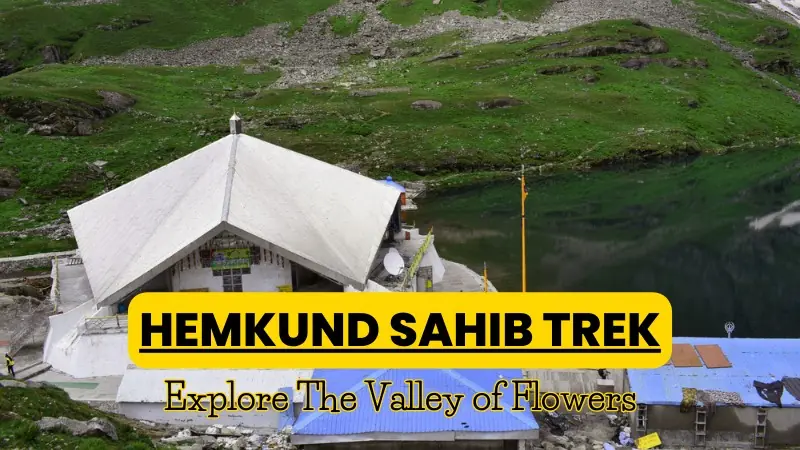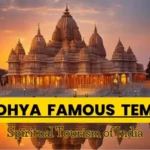Nestled in the breathtaking Himalayas at an altitude exceeding 15,000 ft, the Hemkund Sahib trek is a revered pilgrimage destination for both Sikhs and Hindus. This spiritual haven was constructed in honor of the tenth Sikh guru, Guru Gobind Singh, the visionary behind Sikhism. Guru Gobind Singh would meditate precisely where the gurudwara now stands, drawing thousands of Sikhs annually to pay homage.
What distinguishes this site is its stunning natural backdrop. The Gurudwara overlooks the serene Lokpal Lake, embraced by the majestic Himalayan range from three sides. Two glaciers from the towering peaks of Hathi Parvat and Saptarishi feed the lake, adding to its allure.
Esteemed by Sikhs as a sacred land, the journey to Hemkund Sahib also hosts a shrine dedicated to Lakshmana from the epic Ramayana, making it a significant Hindu pilgrimage site. Lakshmana, wounded by Meghnath, is believed to have sought solace here, leading to the temple’s construction on the banks of Hemkund.
The Hemkund Sahib trek offers a soul-stirring journey, rewarding pilgrims with reflections of snow-capped peaks mirrored in the pristine lake’s waters. Despite the icy coldness of the water year-round, many visitors choose to take a rejuvenating dip.
The enchanting beauty and spiritual significance of the Hemkund Sahib trek make it a must-visit destination for trekkers seeking a divine connection amidst nature’s splendor.
We have a Fleet of Luxury Cars and Luxury Coaches at your service
Best Time to Visit Hemkund Sahib
The optimal time to embark on the Hemkund Sahib trek in Uttarakhand is June to October. While the region maintains a cool climate year-round, it remains largely inaccessible for much of the year. Here’s a detailed breakdown of what to anticipate during each season at this divine destination.
Summer Season (May – June)
The Hemkund Sahib trek commences in May, with remnants of snow still adorning the roads. By June, the snow has melted, ushering in a vibrant bloom of flowers, making it a visually enchanting time to visit Hemkund Sahib. However, if your visit includes the Valley of Flowers, this may not be the ideal time, as the flower variety is limited during this period.
Monsoon Season (July – October)
In my experience, July to August stands out as the prime time to explore the Valley of Flowers and undertake the Hemkund Sahib trek in Uttarakhand. This period sees a profusion of blossoms, offering a diverse array of flowers at both locations. One can also witness the rare Brahma Kamal, which thrives at 15,000 ft. or higher altitudes. For those planning to partake in the journey to Hemkund Sahib, August to October also presents a favorable window. However, due to the monsoon influence in July and August, road conditions may deteriorate, affecting travel plans for September and October. October marks the closure of the gurudwara for the winter season.
Winter Season (November to May)
During this period, the Hemkund Sahib trek is off-limits to pilgrims as the region is blanketed in snow, making it arduous to ascend. Additionally, the residents of Ghangaria relocate to lower altitudes to evade the harsh cold and snow, leaving their homes deserted.
Hemkund Sahib Trek Route Details
Embark on an unforgettable journey along the Hemkund Sahib trek route, a moderate-difficult path that ascends to 4,633 meters above sea level. Your adventure begins in Govindghat, a quaint town nestled by the Alaknanda River. From here, the trail meanders alongside the river, leading you to the picturesque village of Pulna. Traversing through lush forests, crossing charming bridges, and witnessing cascading waterfalls, the well-marked route spans approximately 13 kilometers and takes about 4-5 hours to reach Ghangaria, a vital base camp for both the Hemkund Sahib and Valley of Flowers treks.
The following day, prepare for a challenging 6-kilometer trek to the apex of the journey, Hemkund Sahib. Ascending over 1,000 meters in altitude in a short span, this steep climb through dense foliage and rocky terrain offers awe-inspiring panoramas of snow-capped peaks and glaciers. As you ascend, the trail becomes spiritually enriching, with pilgrims chanting and singing, adding to the mystical ambiance. After a 3-4 hour trek, you’ll arrive at Hemkund Sahib, where the tranquil glacial lake, the Gurudwara, and the temple await. Here, you can partake in a holy dip in the lake, believed to possess healing properties and offer your prayers at the Gurudwara and temple.
Spend some contemplative moments at Hemkund Sahib before retracing your steps back to Ghangaria, a 2-3 hour descent. You can choose to spend another night in Ghangaria or commence your return journey to Govindghat, a 4-5 hour trek, concluding your mesmerizing Hemkund Sahib trek route experience.
Things to do in Hemkund Sahib
Hemkund Sahib isn’t just a place of worship; it’s a realm of marvel and splendor. Your journey here promises to be unforgettable, brimming with enriching experiences. Here are some activities that will transform your trip into a tapestry of memories:
Embrace the Sacred Waters
The glacial lake at Hemkund Sahib trek holds profound significance for Sikhs and Hindus, believed to possess healing properties and the ability to cleanse sins. Despite its icy chill, pilgrims often immerse themselves in its waters, a testament to their adventurous spirit and spiritual devotion.
Offer Reverence at the Gurudwara and Temple
The star-shaped Gurudwara at Hemkund Sahib trek is a magnificent sight, housing the revered Guru Granth Sahib. Visitors can enter, cover their heads, and partake in the hymns and prayers led by the priests. Donations can be made, and Prasad, a sweet offering, is distributed. The temple, dedicated to Lakshmana, the valiant brother of Lord Rama, is a site for quiet contemplation. Legend has it that Lakshmana meditated here after being wounded in battle. Visitors can bow before the idol, light a lamp, or burn incense as a gesture of respect.
Marvel at Nature’s Splendor
Surrounded by seven towering peaks and glaciers, the Hemkund Sahib trek offers a breathtaking view of the Himalayas. The serene landscape is a photographer’s paradise, offering a glimpse into nature’s grandeur. The region is also home to rare flora and fauna, including the Brahma Kamal, Uttarakhand’s state flower, and the elusive blue poppy. Lucky visitors may even spot Himalayan wildlife like bears, snow leopards, and musk deer.
Immerse Yourself in the Journey
The journey to Hemkund Sahib itself is an adventure. The trek offers not just a physical challenge, but a spiritual one as well. The path is steep and challenging, but each step brings you closer to the spiritual sanctum of Hemkund Sahib, offering a unique blend of adventure, spirituality, and natural beauty.





